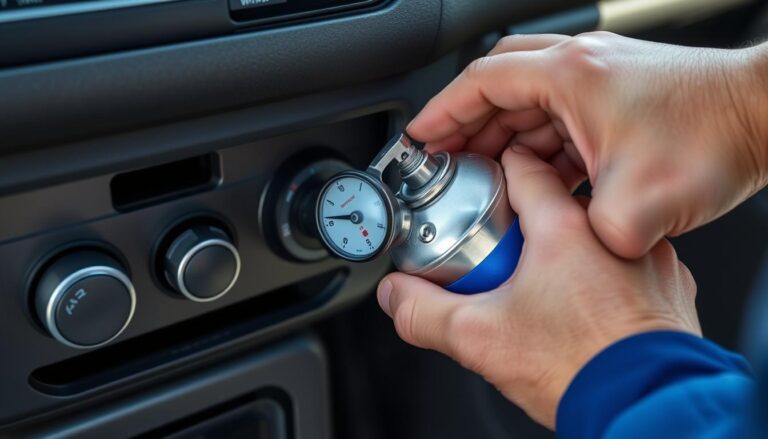Road force testing goes beyond a simple spin to catch issues a standard balancer misses. A road force balancer presses a heavy roller against a spinning tire with roughly 1,200–1,400 pounds of load to mimic how the tire rolls road. Sensors read radial runout, tire stiffness, and construction variations so the tire wheel assembly can roll smoothly under load.
The machine recommends match mounting by aligning the tire’s high spot with the wheel’s low spot. That pairing can cut corrective weight use by about 30%, reduce vibration and steering pull, and improve ride comfort.
Traditional spin balancers only address static and dynamic imbalance. They can’t fix bent rims, out-of-round tires, or road force variation that still transmits vibration at speed. Many shops offer this service in under 30 minutes per wheel and often charge around $25 per tire, though prices vary by market.
Key Takeaways
- Road force testing simulates real load to reveal issues standard balancing misses.
- Machines read tire stiffness and radial runout, then guide match mounting for one optimized tire wheel assembly.
- Proper force balancing can reduce corrective weight needs by about 30% and cut vibration comebacks.
- Traditional spin balancing won’t correct bent rims or out-of-round tires that cause vibration.
- Service often takes under 30 minutes per wheel and commonly costs roughly $25 per tire.
Understanding Road Force, Variation, and Why It Affects Ride Quality
Tire sidewalls act like a ring of tiny springs. When some sections are stiffer than others, each revolution creates small up-and-down pushes. Those pulses travel through the wheel and suspension and show up as vibration in the cabin.
How the balancer checks this
A road force balancer presses a roller against a spinning tire with roughly 1,200–1,400 pounds of load. Sensors measure vertical and lateral forces, plus radial runout and tread inconsistencies. The machine then suggests weight adjustments or reorientation to reduce force variation.
What traditional balancing misses
Static and dynamic balancing only correct mass imbalance with weights. They cannot fix stiffness-driven pulses or a bent rim. That is why match mounting and force balancing matter, especially for low-profile and oversized tires.
| Check | Detects | Fix Method | Notes |
|---|---|---|---|
| Static/Dynamic | Mass imbalance | Wheel weights | Good for simple vibration at low speeds |
| Road force | Tire stiffness & runout | Match mounting, weight + orientation | Simulates how a tire rolls road under load |
| Replacement | Bent rim/out-of-round tire | Repair or replace | When variation exceeds machine correction |
Acceptable Road Force Balance Numbers: What “Good” Looks Like Today
Target thresholds guide technicians toward smoother highway feel and fewer vibration callbacks.
For many shops, a road force value at or below 40 is the goal, with sensitive drivers feeling issues above about 20. Start by correcting basic imbalance, then use the balancer’s guidance for match mounting and retest the tire and wheel pairing.
If readings stay high, swap tires across wheels to find the best tire wheel assembly. Low-profile and oversized off-road tires often need this extra work because added stiffness transmits more vibration into the cabin.
Document final results, minimize corrective weight, and keep the machine printouts for future comparison. For community benchmarks and real-world targets, see this discussion on road force targets: road force targets.
FAQ
What is road force variation and how does it affect ride quality?
Road force variation is the change in force around a tire as it contacts a roller. It comes from tire stiffness differences, radial runout, and sidewall spring effects. These variations can cause vibration, uneven wear, and steering feedback because the wheel-tire assembly transmits inconsistent loads to the suspension and chassis.
How does a road force balancer work?
A road force balancer spins the tire and wheel while a roller applies a controlled load—typically between 1,200 and 1,400 pounds—to simulate road contact. The machine measures force peaks and low points, locates stiffness or runout issues, and helps technicians decide whether to match-mount, add weights, or replace components to reduce vibration.
What’s the difference between static balance, dynamic balance, and road force testing?
Static and dynamic balancing address mass imbalance by adding weights to correct high spots while the wheel spins. Road force testing goes further: it evaluates how the tire deforms under load and identifies stiffness variations that balancing alone won’t fix. That’s why a spinning wheel can still vibrate even after standard balancing.
Which measurements indicate a healthy tire and wheel assembly?
A healthy assembly shows low measured force variation and minimal radial runout. Technicians look for consistent readings around the circumference, steady rim and tire runout values, and small stiffness peaks. When values are low and consistent, the vehicle should have a smooth ride and predictable wear pattern.
When should a tire be match-mounted or re-located on the rim?
Match-mounting pairs the tire’s low-force spot with the wheel’s high spot to minimize combined variation. Re-locating the tire on the rim by a few degrees can reduce measured peaks. These steps are recommended when the balancer shows a significant mismatch between tire stiffness and rim geometry but the components themselves are otherwise serviceable.
Can adding wheel weights fix every vibration issue?
No. Adding weights corrects mass imbalance but won’t resolve stiffness-related vibration or excessive radial runout. If the root cause is a stiff patch in the tire or a bent rim, match-mounting or replacement may be required. Road force diagnostics identify which approach will work best.
How does tire wear or damage show up in road force testing?
Wear, belt separation, and tread damage often create localized stiffness changes or increased runout. The balancer will flag higher peaks in specific sectors. Those readings point technicians to inspect the tire for internal damage, uneven tread wear, or cord issues that justify repair or replacement.
Should I worry if a wheel has small amounts of radial runout?
Small amounts are common and often acceptable, especially if combined variation remains low. However, excessive radial runout can transmit vibration through the suspension. Road force testing helps determine whether the combined effect of tire and rim runout requires correction or replacement.
Do tire pressure and temperature affect road force readings?
Yes. Tire pressure and temperature change stiffness and contact patch behavior. Technicians set recommended inflation and allow tires to stabilize before testing. Consistent test conditions ensure accurate comparisons and valid decisions about balancing, match-mounting, or replacement.
When is replacement the best option instead of balancing or match-mounting?
Replacement is best when a tire shows internal damage, belt separation, or persistent high stiffness peaks that cannot be corrected by mounting adjustments. A bent or cracked rim that can’t be safely repaired also warrants replacement to restore ride quality and safety.
How often should I have road force testing performed?
Have testing done when you experience vibration that normal balancing didn’t fix, when mounting new tires, or after repairing a puncture with internal patches. It’s also useful during routine tire services to catch developing issues early and extend tire life.
Can reputable brands and shops guarantee vibration-free results after testing?
Reputable shops using modern balancers and following best-practice match-mounting and inspection can greatly reduce vibrations. However, if tires or rims have inherent defects, a guarantee may require replacement. Always ask about warranty coverage and follow manufacturer recommendations.


